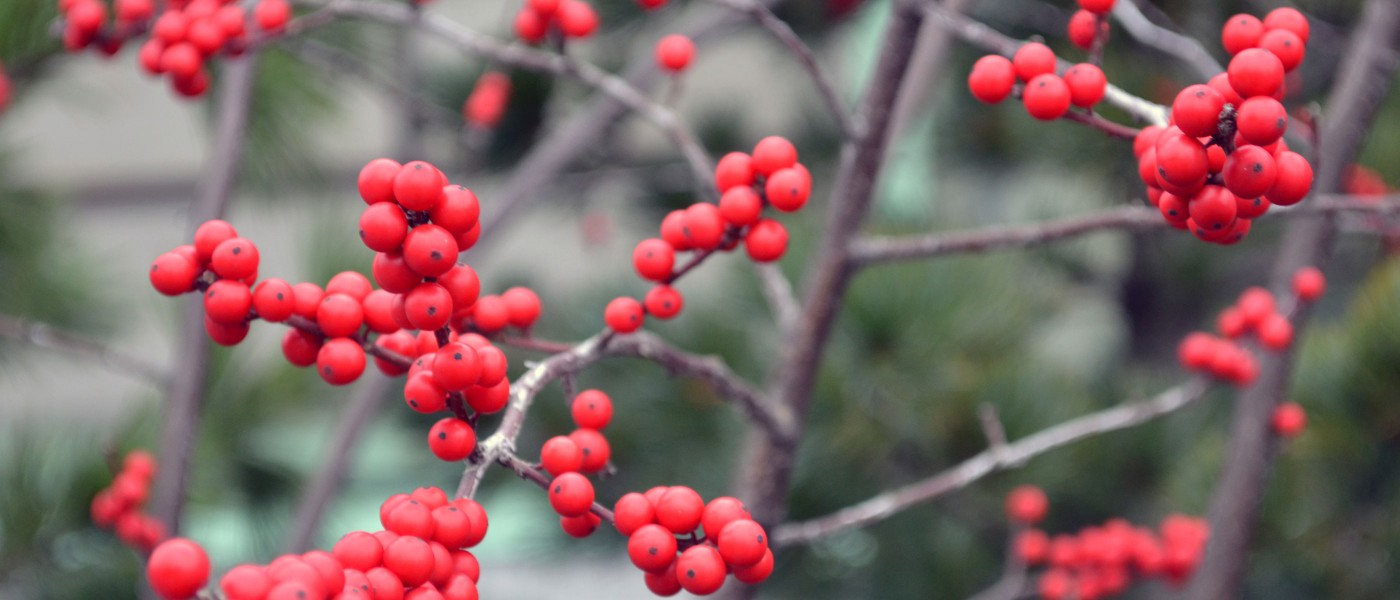Winter Highlights
Winter reveals the architecture of natural forms and pops of color in a contemplative landscape. Or, transport yourself to a warm ecosystem in one of the Garden's conservatories.
Aquatic House and Orchid Collection: Another, Warmer, World
Step indoors to the lush environment of the glass-enclosed Aquatic House, where it’s warm, moist, and often sunny even in the dead of winter. Tropical and subtropical plants cascade from hanging pots and tree trunks, grow skyward from beneath the water, or float on the surface of the pools.
Look for
- Carnivorous plants, mangrove trees, large Moco moco (Montrichardia arborescens) plants, and potted water lilies in the bog environment at the south end of the shallow pool.
- Colorful orchids blooming throughout the house. Most are epiphytes—plants that use other plants for support and get moisture and nutrients from the air. Some hang from wooden pots or racks. Others are growing on tree trunks as they would in their native habitat.
- More orchids in the display cases. There are thousands of orchids in the Garden’s collection, and the most spectacular are placed on view here when they bloom.
The Aquatic House is particularly inviting on a cold day, but orchids bloom here throughout the year. Be sure to visit in other seasons to see more of the collection.
Rock Garden: Alpine Habitats, Conifers, and Winter Blooms
The Rock Garden includes a variety of microclimates, including several alpine habitats, set apart by carefully arranged boulders.
Look for
- A wide variety of conifers native to mountainous regions including the Rocky Mountains and Northern Europe.
- Witch-hazels. These ribbon-like flowers bloom in winter, usually during a warm spell, but persist for weeks, giving off a light, citrusy scent.
- Hellebores, another winter bloomer. This delicate but tough perennial, a member of the buttercup family, is forgiving enough to thrive in a small, partially shady New York City garden.
Japanese Hill-and-Pond Garden: Graceful Evergreens, Snow Lanterns, and Winter Wildlife
Traditional Japanese gardens highlight seasonal change so that there’s something beautiful and interesting to experience all year. Winter is the perfect time to enjoy the quiet beauty and stark forms that are revealed once the leaves have fallen from the deciduous trees. The garden is especially enchanting after a snowfall.
Look for
- Artfully pruned evergreen trees and shrubs. In Japanese gardens, trees are often intentionally shaped to look weathered and old. Proper pruning also allows them to gracefully hold snow.
- The yukimi gata (“snow-viewing”) lantern on Turtle Island. After a snowfall, its wide, flat roof holds a blanket of snow.
- Resident wildlife. A pair of hawks often comes by to hunt, while cardinals can be seen foraging for seeds and nuts. The great blue heron is a regular visitor who likes to stalk the shores and shallow waters while fishing, and koi occasionally appear at the pond’s surface.
This garden was also designed to appeal to different senses. Notice the scent of the pines and the sounds of animals, feel a winter breeze across the water, and listen to your own footsteps crunching on the gravel paths on a quiet day.
Conservatory Pavilions: Desert Blooms, Tropical Fruit, and Gorgeous South African Flowers
The Steinhardt Conservatory’s three indoor pavilions are climate controlled to replicate different ecosystems: an arid desert, a humid tropical rainforest, and the mild warmth of the Mediterranean, California, and South Africa.
Look for
- The colorful tubular flower spikes of aloes blooming in the Desert Pavilion.
- South African bulbs like Natal-lily, cobra-lily, and bird-of-paradise blooming in January and February in the Warm Temperate Pavilion. The fragrant olive blossoms also smell wonderful at this time of year—you may notice the lovely scent before you can identify its source.
- Loquat, papaya, guava, and other tropical fruits and flowers growing high up in the branches of the Tropical Pavilion's trees.
Plants from different regions that share the same growing conditions grow together here: African honeysuckle and Provence lavender in the Warm Temperate Pavilion, Mexican cacti and succulents from Madagascar in the Desert Pavilion, and South American anthuriums and fishtail palms from Asia in the Tropical Pavilion.
Also see
Crabapples in the Osborne Garden, and hollies in the Plant Family Collection and Shakespeare and Native Flora Gardens. Winterberries and fruits are an important food source for resident birds.
Fascinating buds that may have fuzzy scales or emerge in colorful clusters, as well as tree bark that peels or twists or seems to almost glow like fire.
Perennial seedheads—fluffy and windswept, providing food and shelter for birds and insects—throughout the Discovery Garden and around the Visitor Center.
The deceptively quiet forest of the Native Flora Garden. The bare branches may appear dead, but inside, they are preparing for spring.


